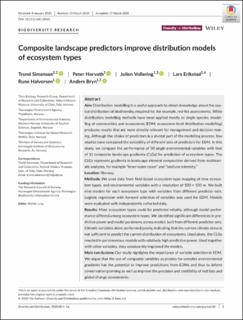| dc.contributor.author | Simensen, Trond | |
| dc.contributor.author | Horvath, Peter | |
| dc.contributor.author | Vollering, Julien | |
| dc.contributor.author | Erikstad, Lars | |
| dc.contributor.author | Halvorsen, Rune | |
| dc.contributor.author | Bryn, Anders | |
| dc.date.accessioned | 2021-02-04T17:58:24Z | |
| dc.date.available | 2021-02-04T17:58:24Z | |
| dc.date.created | 2020-06-10T13:55:47Z | |
| dc.date.issued | 2020-06-10 | |
| dc.identifier.citation | Simensen, T, Horvath, P, Vollering, J, Erikstad, L, Halvorsen, R, Bryn, A. Composite landscape predictors improve distribution models of ecosystem types. Divers Distrib. 2020; 26: 928– 943. | en_US |
| dc.identifier.issn | 1366-9516 | |
| dc.identifier.uri | https://hdl.handle.net/11250/2726281 | |
| dc.description.abstract | Aim: Distribution modelling is a useful approach to obtain knowledge about the spatial distribution of biodiversity, required for, for example, red-list assessments. While distribution modelling methods have been applied mostly to single species, modelling of communities and ecosystems (EDM; ecosystem-level distribution modelling) produces results that are more directly relevant for management and decision-making. Although the choice of predictors is a pivotal part of the modelling process, few studies have compared the suitability of different sets of predictors for EDM. In this study, we compare the performance of 50 single environmental variables with that of 11 composite landscape gradients (CLGs) for prediction of ecosystem types. The CLGs represent gradients in landscape element composition derived from multivariate analyses, for example “inner-outer coast” and “land use intensity.” Location: Norway. Methods: We used data from field-based ecosystem-type mapping of nine ecosystem types, and environmental variables with a resolution of 100 × 100 m. We built nine models for each ecosystem type with variables from different predictor sets. Logistic regression with forward selection of variables was used for EDM. Models were evaluated with independently collected data. Results: Most ecosystem types could be predicted reliably, although model performance differed among ecosystem types. We identified significant differences in predictive power and model parsimony across models built from different predictor sets. Climatic variables alone performed poorly, indicating that the current climate alone is not sufficient to predict the current distribution of ecosystems. Used alone, the CLGs resulted in parsimonious models with relatively high predictive power. Used together with other variables, they consistently improved the models. Main conclusions: Our study highlights the importance of variable selection in EDM. We argue that the use of composite variables as proxies for complex environmental gradients has the potential to improve predictions from EDMs and thus to inform conservation planning as well as improve the precision and credibility of red lists and global change assessments.conservation planning, distribution modelling, ecosystem classification, ecosystem types, IUCN Red List of Ecosystems, landscape gradients, spatial prediction, species response curves | en_US |
| dc.language.iso | eng | en_US |
| dc.publisher | John Wiley & Sons Ltd. | en_US |
| dc.rights | Navngivelse 4.0 Internasjonal | * |
| dc.rights.uri | http://creativecommons.org/licenses/by/4.0/deed.no | * |
| dc.title | Composite landscape predictors improve distribution models of ecosystem types | en_US |
| dc.type | Peer reviewed | en_US |
| dc.type | Journal article | en_US |
| dc.description.version | publishedVersion | en_US |
| dc.rights.holder | © 2020 The Authors | en_US |
| dc.subject.nsi | VDP::Økologi: 488 | en_US |
| dc.subject.nsi | VDP::Ecology: 488 | en_US |
| dc.source.pagenumber | 928-943 | en_US |
| dc.source.volume | 26 | en_US |
| dc.source.journal | Diversity and Distributions: A journal of biological invasions and biodiversity | en_US |
| dc.source.issue | 8 | en_US |
| dc.identifier.doi | 10.1111/ddi.13060 | |
| dc.identifier.cristin | 1814808 | |
| dc.relation.project | Norges forskningsråd: xxxxxxxx | en_US |
| cristin.ispublished | true | |
| cristin.fulltext | original | |
| cristin.qualitycode | 1 | |

